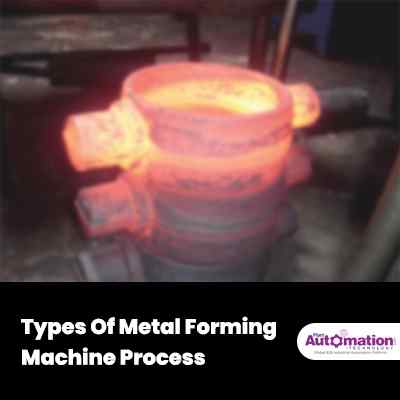Types Of Metal Forming Machine Process

In the past few years, the adoption of automated machine tools has increased considerably along with the rising investments in the industrial manufacturing sector. There will not only be an increase in productivity, but automation of manufacturing processes helps in making professionals quite efficient and flexible during emergencies and also helps in prioritizing the overall workflow. During the forthcoming years, the increasing adoption of automation in large-scale industries will be one of the main factors driving the market's growth. Owing to the increasing adoption of robotics and automated equipment, the market growth of metal forming machine process is likely to spur positively in the upcoming years, particularly, in the manufacturing sector. The manufacturing companies can manage high-quality processes as automation removes the scope for human error and impacts the overall quality of production.
The market of metal forming machine process is moderately fragmented presently, owing to the presence of metal forming machine tool manufacturers bringing out advanced technologies to offer superior products to the end-user industries. A complete analysis of the market's competitive landscape and information on the products offered by the companies will help clients in identifying new growth opportunities and designing new growth strategies for improving the market shares in this competitive environment. Metal forming and machining are the two prominent methods to convert raw material into a product. Changing the shape of the material by permanent plastic deformation is best defined as metal forming. The only advantage with the metal forming process is there will be no wastage of the raw material, faster production rate, and better mechanical properties of the product.
| Also Read: Precision in Action: Exploring Machine Tools for Metal Forming |
Metal Forming Machine Process
The metal forming machine process is classified into - bulk forming and sheet forming processes. Bulk-forming is further divided into rolling, forging, extrusion, and wire or rod drawing whereas the sheet forming is divided into bending, deep/cup drawing, shearing.
BULK FORMING
A metal forming severe deformation process that results in a massive change in shape. The surface-area-to-volume is comparatively small. Typically done in hot working conditions.
A) ROLLING
Rolling is a type of metal forming machine process in which a metal stock/workpiece is compressed or passed through one or more pairs of rolls to reduce the thickness and make it uniform. The rotating rolls draw the metal stock into the gap and compress it. The final product obtained is in the form of a sheet. According to the temperature of the metal rolled, the rolling process is further classified into hot and cold rolling. If the metal's temperature is above its recrystallization temperature, then the process is known as hot rolling, and if it's below the recrystallization temperature, then it's known as cold rolling. Rolling is used to produce semi-finished products such as sheets, plates, bars, and finished products such as channels, angles, and sections. The rolling processes include-
- Flat rolling
- Shape rolling
- Ring rolling
- Thread rolling
- Gear rolling
B) FORGING
With the help of a pair of tools called die and punch, the workpiece or billet is shaped into the finished part by the application of tensile and compressive forces. It's a bulk-forming process that can be done in open or closed dies. Usually, the open die forming is used for the preliminary shaping of raw materials into a form suitable for subsequent machining or forming. It's done for operations such as thinning, drawing out, etc., whereas in closed die forming the raw material (billet) is squeezed inside the cavity formed between a pair of shaped dies. The closed die forming produces pump parts, small gears, valve parts, spanners, connecting rods, etc. According to the temperature at which it's performed, forging is often classified into cold, warm, and hot forging. The metal is heated usually in a forge for the latter two.
Another process called coining is quite evident in the bulk-forming process which is done by applying compressive stress on the surface of the raw material to impart special shapes onto the surface from the embossing punch. The common forging processes are -
- Roll forging
- Cogging
- Open-die forging
- Swaging
- Press forging
- Impression-die forging
- Upsetting
- Automatic hot forging
C) EXTRUSION
In the extrusion metal forming process, the raw material is forced through a narrow opening of a constant or varying cross-section to increase the length and reduce the diameter. The metalwork is pushed through the die opening. The extrusion process can be done hot or cold. Tubes, cans, shafts, cups, cans, and gears are the extruded products in the process. There are mainly two methods of extrusion - forward and backward extrusions. The workpiece and the extrusion punch move along the same direction in forward extrusion, while in backward extrusion the punch moves opposite to the direction of movement of the workpiece. Polymers, concrete, metals, ceramics, metals, foodstuffs, and modeling clay are commonly extruded materials. The different types of extrusion processes are -
- Direct
- Indirect
- Hydrostatic
- Tube
D) WIRE/ROD DRAWING
This metal forming process is similar to extrusion. The only difference is the application of force to the workpiece. In this process, the workpiece is pulled through the die opening and forming is done over its cross-section. With the application of tensile force, small diameter wires from rods are produced by minimizing their diameter and stretching their length. Seamless tubes can also be produced by the tube drawing process. The drawing process can be divided into the following types.
- Wire drawing
- Rod drawing
- Tube drawing
SHEET FORMING
It’s a metal forming machine process that includes both forming and cutting operations usually performed on strips, metal sheets, and coils. Unlike bulk-forming, the surface area-to-volume is relatively high in sheet forming. Die, punch are the tools used to deform the sheets.
A) BENDING
A bending machine is a machine forming tool that involves the deformation of the work by bending about a certain axis. The sheet material is strained by a punch to give a bend/angle in V, U or channel shape, usually in a straight axis. Box and pan brakes, brake presses, and other specialized machine presses are the commonly used equipment. The bending of sheets includes swivel bending, rotary bending, roll bending using rotary die. Different types of bending processes are -
- Air bending
- Bottoming
- Coining
- Three-point bending
- Folding
- Wiping
- Rotary bending
- Roll bending
- Elastomer bending
- Joggling/Joggle bending
B) DEEP/CUP DRAWING
A metal forming process in which a flat piece of plate or sheet is drawn radically into a forming die by the mechanical action of a punch, to take a shape such as a cup. This process is considered deep drawing when the intensity of the drawn part exceeds its diameter. The complex shapes can be produced by the deep drawing of blanks in stages such as redrawing, multiple draw deep drawing, etc.
C) SHEARING
Also known as shear spinning, this metal forming process is similar to metal spinning. It's nothing but the cutting of sheets by shearing action. Gas turbine engine, dish aerials, rocket nose cones are the typical components produced by mechanically powered spinning machines. The different types of shears that are used to shear sheet metal are -
- Alligator shear
- Guillotine
- Bench shear
- Power shears
- Tin snips
- Throatless shear
Top Manufacturers In The Metal Forming Device Market Competition Globally Are -
As per industry reports -
- JET Tools, North America
- Tennsmith, USA
- Formtek, USA
- Samco, Canada
- Ampco Metal, Switzerland
- Diacro, USA
- Bradbury Group, USA
- Mestek Machinery, USA
- Westway Machinery, Canada
- Wuhan Huagong, China
- AVIC manufacturer, China











